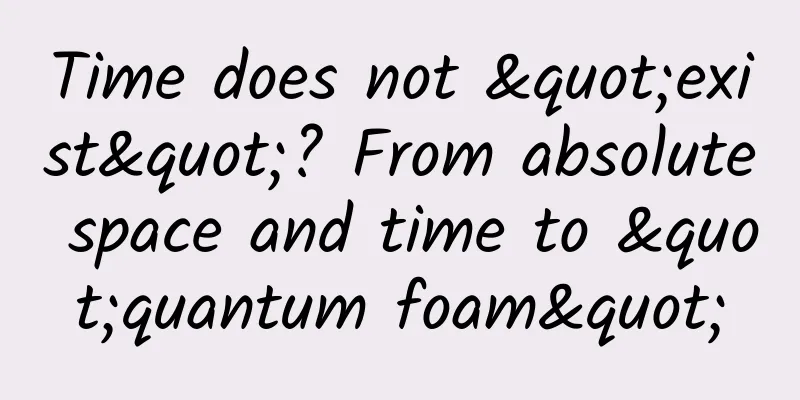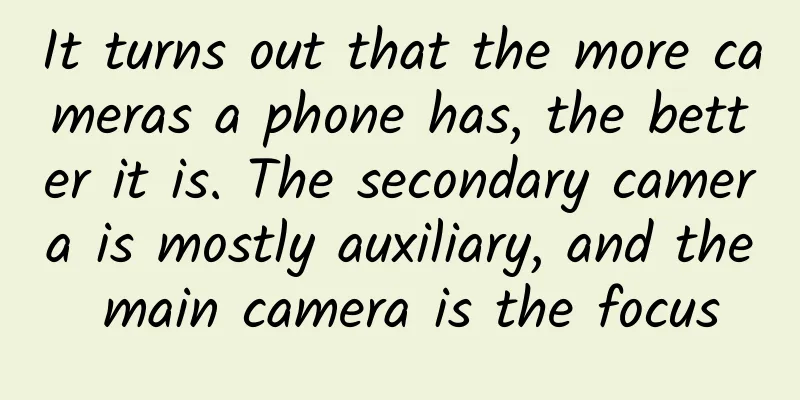Time does not "exist"? From absolute space and time to "quantum foam"

|
From absolute space and time to quantum foam In the long journey of human beings trying to understand the universe, time and space have always been the most basic concepts. We live on a stage composed of time and space, and all events occur and unfold on this stage. With the development of physics, the nature and relationship of time and space are constantly being redefined. This exploration process goes from Newton's absolute time and space, to Einstein's theory of relativity, to quantum and cosmology in modern physics. What is quantum foam? Why did Academician Shi Yigong say "time does not exist"? Let's reveal this mysterious space-time picture together. From absolute space-time to relative space-time In the 17th century, Newton proposed the classical concept of time and space. In Newton's theoretical framework, time and space are completely independent and absolute. Time is like a uniformly flowing line that remains consistent under any conditions and positions; space is an infinitely extended container in which objects move freely. Time and space constitute a stage that is not affected by objects or events, and all physical phenomena are performed on it. This concept not only laid the foundation of classical physics, but also formed the core of the mechanical cosmology, which believes that the universe is like a huge clock driven by the interaction of objects and forces. Before the theory of relativity was proposed, Newton's absolute view of time and space was widely recognized, especially in his book "Mathematical Principles of Natural Philosophy", in which Newton systematically expounded on the view of absolute time and absolute space. In Newton's mechanical system, the inertial system is defined as a reference system that is stationary or in uniform linear motion relative to absolute space. Galileo's principle of relativity was further elaborated and developed under the framework of Newton's absolute view of time and space. The Galilean transformation describes the conversion of space and time between different inertial systems, indicating that the scale of time and space remains unchanged in different inertial systems. In other words, not only are time and space absolute, but simultaneity is also absolute - if two events are observed to occur simultaneously in one inertial system, then this is true in all inertial systems. To prove the existence of absolute space, Newton designed a famous physics experiment, the Newton bucket experiment: there is a bucket filled with water. Initially, when the bucket and the water are both still, the water surface is flat. As the bucket begins to rotate, the water surface remains flat when the water and the bucket have not yet rotated synchronously; when the water gradually rotates synchronously with the bucket, the water surface becomes concave. Even if the bucket eventually stops rotating, the water will continue to rotate and the water surface remains concave. Newton believed that the concave shape of the water surface is due to the inertia caused by the rotation of water relative to absolute space, indicating that the motion state of water depends on a certain absolute reference system, thus supporting the existence of absolute space. Figure Newton bucket experiment In the 19th century, Maxwell's electromagnetic theory once again promoted the development of physics. He unified electricity, magnetism, and light through a set of equations. However, at that time, the physics community generally believed that electromagnetic waves needed ether as a propagation medium. There was a key problem with this theory: if the earth moves in the ether, then the speed of light measured in the direction of the earth's movement should change, just like walking against the wind slows down. Scientists tried to prove the relative motion between the earth and the ether through the Michelson-Morley experiment, which was the starting point for Michelson and Morley to verify. In 1887, American physicists Albert Michelson and Edward Morley designed a sophisticated interference experiment, known as the Michelson-Morley experiment. The experimental setup mainly consists of an interferometer, which splits a light beam into two paths, one along the direction of the Earth's revolution and the other perpendicular to the direction of the Earth's movement. By comparing the optical path difference between the two paths, they tried to detect the movement of the Earth in the ether, the so-called ether wind. According to the ether hypothesis, if the earth is traveling through the ether, the speed of light along the direction of the earth's movement should slow down, while the speed of light in the perpendicular direction remains unchanged. The idea of the experiment is that when the two light beams reunite, a certain amount of interference fringes will be offset, indicating that the speed of light is affected by the movement of the earth. However, the experimental results were completely unexpected - there was no significant difference in the speed of light of the two light paths, and the interference fringes did not shift as expected. This result shows that the speed of light seems to be the same regardless of whether the earth is moving or not. However, the experimental results show that the speed of light is constant and has nothing to do with the direction of the earth's movement. This discovery conflicts with the Galilean transformation, because according to the Galilean transformation, the speed of light in different inertial systems should change with relative motion. Maxwell's electromagnetic theory stands on the opposite side of traditional classical mechanics in this contradiction. Figure Michelson-Morley ether wind experiment It was not until the early 20th century that Einstein's theory of relativity emerged, which completely overturned the traditional concept of absolute time and space and resolved the above conflict. He proposed that the speed of light is constant and is a constant in any inertial system. This principle laid the core of the theory of relativity. Through his special theory of relativity, Einstein pointed out that time and space are not independent, but closely related and constitute a four-dimensional space-time whole. The position of each object in the universe is determined not only by the three-dimensional spatial coordinates, but also by the time coordinates. In his theory, time and space are no longer fixed. As the speed of an object approaches the speed of light, time slows down for the observer and space shrinks. Einstein introduced this framework to give time and space a unified nature. As mentioned earlier, a core assumption of the special theory of relativity is the principle of the constancy of the speed of light, which states that the speed of light in a vacuum is always constant regardless of the speed of the observer. This principle is crucial to the phenomena of time dilation and length contraction. The measured speed of light is always the same regardless of whether the observer is moving relative to the light source or not. Einstein also proposed the principle of relativity, which states that the laws of physics are the same for all inertial reference frames and do not change due to the state of motion of the observer. The principle of relativity, combined with the constancy of the speed of light, explains why time and space change with speed. This phenomenon shows that time and space are relative and depend on the state of motion of the object. So going a step further, in the general theory of relativity, Einstein revealed the nature of gravity. Gravity is not the attraction between objects, but the distortion of the surrounding space-time by mass. Space-time can be likened to a taut rubber membrane. When a large mass object is placed on it, the rubber membrane will sink to form a depression, and other smaller objects will slide along this depression to the center of the large mass. Quantum foam According to the description in the theory of relativity, we regard it as a smooth, continuous four-dimensional structure, which can describe the movement of celestial bodies and the movement of objects in macroscopic space. However, with the rise of quantum mechanics, in the quantum world at the microscopic scale, scientists have discovered that the nature of space and time is far more complex and mysterious than we imagined. One of the core principles of quantum mechanics is the Heisenberg uncertainty principle, which means that we cannot accurately measure the speed and position of a particle at the same time. It can be understood that at the scale of daily life, space can be accurately measured and the position seems to be fixed. But at the quantum scale, the measurement of position and speed is limited, and the behavior of particles also shows uncertainty. This characteristic means that space may also be full of fluctuations on a tiny space-time scale. It is no longer static, but constantly changing and extremely active. This phenomenon cannot be described in macroscopic physics, but in quantum physics, it is a basic property that cannot be ignored. In this context of uncertainty, scientists have proposed the concept of quantum foam. When we observe extremely small space-time scales, space is not as smooth as the macroscopic world, but presents random fluctuations similar to foam. This foam is composed of many tiny particles and energy that are briefly generated and quickly annihilated, forming a dynamic structure. This is like the waves seen on the surface of the sea. Although the water surface is coherent as a whole, there are waves that are constantly generated and disappearing at specific points in space and time. Scientists further speculate that the performance of space-time at the quantum level may be a complex dynamic network, and the smooth space-time we observe is only its performance at the macroscopic scale. Similar to the waves in the ocean that appear endless when viewed from a distance, while microscopic observation reveals countless surging water molecules, quantum foam shows that the basic composition of space-time may be an extremely active network structure. This quantum foam phenomenon is not only a speculation of quantum mechanics, but also an important clue connecting quantum physics and general relativity. Einstein's theory of relativity successfully describes the gravitational relationship between macroscopic celestial bodies, but how to unify quantum mechanics and gravitational theory at the microscopic level is still an unsolved problem in the scientific community. Quantum foam is considered to be a manifestation of quantum gravity, which means that gravity may also work in a completely new way at an extremely small scale. If these theories can be further verified, then quantum foam may become a key element in the scientific community's understanding of space-time. |
<<: Why do I always have two annoying bulges on my knees? Can I straighten them?
Recommend
There has never been an article that can explain operations in such a down-to-earth way!
On New Year’s Eve in 2015, it was a dark and wind...
This article explains all the operating skills of Weibo, Tik Tok, and Bilibili!
Faced with today's increasingly segmented, fr...
Block Tesla and see who are the competitors of Model 3
Tesla's recently released Model 3 entry-level...
Millions of IPs create science and technology talents to strengthen the country | Protecting the agricultural fire in the "Seed Noah's Ark"
The picture shows the germplasm resources preserv...
Samsung S8 is priced cautiously to please Chinese users. Do you buy it?
Samsung's new generation flagship smartphone ...
What happened to the Saudi stock market crash? Why did the Saudi stock market plummet?
The Saudi stock market, which also traded on Sund...
8-year-old boy injured by glass bottle explosion! Dry ice is non-toxic but don’t play with it!
Authors: Duan Yuechu, Huang Xianghong, Huang Yanh...
[Operation Case] In-depth interpretation of community operation, this is my ten thousand word summary after experiencing four communities
A mature community is like a city. It manages its...
Experience and tips on how to increase followers and monetize on Toutiao!
In mid-September 2016, I registered a Toutiao acc...
Three veterans in charge of iPhone design resigned, causing a major personnel shakeup in Apple's industrial design team
According to the Wall Street Journal, Apple's...
5 Ways to Use KOL Marketing
Now if you ask yourself what a KOL is, can you an...
Prices of various types of Moutai liquor plummeted across the board
Dongguan Fengchao.com reported on October 31 that...
Can a galaxy grow larger by swallowing another galaxy like a black hole?
This article is based on answering similar questi...
I heard that the word "evolution" can no longer be used?
The word "Evolution" has two translatio...
The super cool starry sky "palette" in the hands of the cosmic painter, you may have never seen it before
Author | Feng Ziyang Review | Dong Chenhui Editor...









